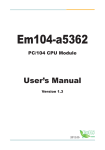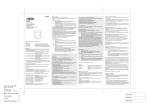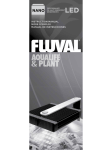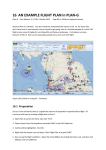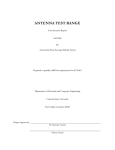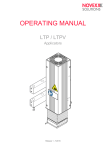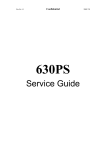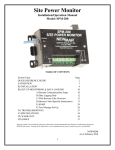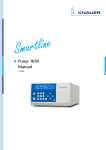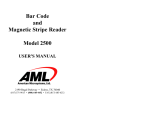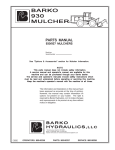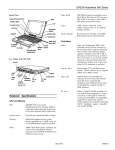Download Aeronca Oil Sumps rev8
Transcript
Aeronca Oil Sumps By John Propst with technical overview by Bill Pancake Abstract This article covers oil sumps used on post war Aeronca Champs and Chiefs. Before addressing the topic of oil sumps, a few words are in order to discuss aircraft and engine specifications as they relate to Aeronca airplanes. There are two primary documents that define the requirements and specifications for an airplane. The first is the aircraft Type Certificate and the second is the engine Type Certificate. These documents are filed with the FAA by the aircraft manufacturer and the engine manufacturer and are updated from time to time to reflect updated and revised specifications. As it relates to the oil sumps, the engine type certificate specifies the oil sump capacity and type of engine lubricant. As it relates to the oil sumps, the aircraft type certificate specifies the engine manufacturer and engine model, and the oil sump capacity. In general it is the aircraft manufacturer’s responsibility to specify and define all the engine “accessories” including the air box, starter, generator, magnetos, exhaust system, propeller, filters, fuel pump, and oil sump. Most of these accessories are fabricated and sold by third party manufacturer. Oil sumps are an exception in that most oil sumps are manufactured by the engine manufacture in accordance with the aircraft manufacturer’s specifications. This is done to assure the sump will fit within the confines of the engine mount, aircraft cowling, and other physical constraints. The oil sumps for Aeronca aircraft are generally specified on Aeronca aircraft engine assembly and installation drawings. For example, Aeronca drawing 7-446 specifies an A50331 sump for the 7AC aircraft with an A65 engine. Likewise Aeronca drawing 7-502 specifies the same sump for the 11AC aircraft with the A65 engine. It would seem that there would not be any issues related to the oil sump for Aeronca aircraft. The problem that arises is that Continental manufactures seven different oil sumps for the A65 engine. There are at least twelve additional sumps manufactured for C75, C85, C90, and O-200 engines. There are also equal numbers of different caps for the oil sumps. This results in over 300 different possible combinations of sumps and oil caps available for installation on the Continental engine in your Champ and Chief. Table 1 on the next page displays all the Continental oil sumps for engines A50 through O-200. Several lines in the table are highlighted for Aeronca applications. The drawing to the left is a portion of Aeronca drawing 4-613. This drawing specifies the exact length and location of the filler neck with respect to the tank for the A50331 sump for the A65 engine on the 7AC and 11AC aircraft. Likewise it shows the markings on the A35919 cap. Revision - 8 Jan 2, 2013 Written by John Propst Reviewed by Bill Pancake 1 Other sumps shown in table 1 may well have been developed by Continental for other makes and models of aircraft and may have the filler neck located in a different position and different angle than the sump for Aeronca airplanes. Over the years it was not at all that uncommon for an engine from one make and model of aircraft to be removed and reinstalled on an Aeronca aircraft. Often when the engine swaps were being made many of the engine accessories including the sump, air box, mags, and propeller were also included in the swap. As a case in point, when purchased, the author’s 7AC Champ with a C85-12 engine had an oil sump manufactured for an Aircoupe with the filler neck located on the left side of the engine. Sump Part No Cap Part No. Engine Model Drain Plug Drain Gasket Sump Gasket Capacity Qt A5362 A5230 A5363 A5458 A5461 A5479 A3657 A3966 A3680 A3896 A3970 A35017 A50, A65, A75, A80 A50, A65, A75, A80 A50, A65, A75, A80 A50, A65, A75, A80 A50, A65, A75, A80 A50, A65, A75, A80 2265 2265 2265 2265 2265 2265 AN900-10 AN900-10 AN900-10 AN900-10 AN900-10 AN900-10 3577 3577 3577 3577 3577 3577 4 4 4 4 4 4 A50331 A5230 A50374 A5230 530091 A5460 A5373 A50337 A5460 A50351 A50331 A50351 A35919 A3966 A36006 A36026 A36026 A36036 A36037 A36038 531057 A36039 A36103 A36111 A50, A65, A75, A80 a,b c,e b,e b,e b B c c b b c,b,f,g 2265 2265 2265 2265 2265 2265 2265 2265 2265 2265 2265 2265 AN900-10 AN900-10 AN900-10 AN900-10 AN900-10 AN900-10 AN900-10 AN900-10 AN900-10 AN900-10 AN900-10 AN900-10 3577 3577 3577 3577 3577 3577 3577 3577 3577 3577 3577 3577 4 4 4.5 4.5 4.5 4.5 4.5 6 4.8 5 4.5 6 530473 A5230 530475 530667 c,d c,d,f 2265 2265 AN900-10 AN900-10 3577 3577 5 4.8 Model codes a b c d e f g C75-12, C75-12FJ C85-8, C85-8F, C85-8FJ, C85-12 C90-8F, C90-12F, C75-12F C90-8F, C90-8FJ C85-12 with dual fuel pump equipment C90-14F O-200-A 7AC and 11AC per dwg 7-446 and 7-502 7BCM per dwg 7-599 O-200 7EC, 7FC per Aeronca Operating and Service Manual. For 7CCM per dwg 7-599 Table 1 – Continental Oil Sumps A50 through O-200 Likewise, often when an aircraft experienced a nose-over wreck, the oil sump was one of the lowest points on the front of the aircraft resulting in the sump being damaged or destroyed. This often resulted in the most convenient “spare” oil sump being reinstalled on the repaired engine. Revision - 8 Jan 2, 2013 Written by John Propst Reviewed by Bill Pancake 2 All this is to say that when swapping an engine from one aircraft to another, the accessories, including the oil sump, approved for one aircraft may not be suitable for other aircraft. In the photo to the left Bill Pancake is holding an A50331 oil sump used on an Aeronca A-65 engine in his right hand, and an oil sump used on a Cub with a similar A65 engine in his left hand. Note the difference in the length and position of the filler neck. It should also be noted that the Aeronca sump was made from much heavier steel and weighed considerably more than the Cub sump. In Table 1, the O-200 sump is highlighted on the table only because it is a 6 quart sump that was common on Cessna 150’s. When Aeronca aircraft are updated with the Aeronca 26 gallon fuel system kit #192, FAA’s oil-to-onboard fuel capacity specification requires increasing the oil sump capacity to at least 5 quarts. While there is a Continental 5 quart sump used on the C90 7EC and 7FC, the 6 quart sump from the O-200 engine is often easier to find and commonly used with this conversion. Additional information related to oil sump capacity as it relates to aircraft fuel capacity and horsepower can be found in the Civil Air Regulations (CAR) part 4, section 621. CAR part 4 is referenced in the aircraft type certificate. Another issue related to oil sumps is that it is not easy to determine which sump is installed on your engine just by looking at it. The sump part number shown on table 1 is usually stamped on the face of the flange of the oil sump, as shown on the photo to the left. Therefore you can only see the part number when the sump is removed. If the sump is removed from your engine for any reason, be sure to record the part number for the oil sump. Note that many of the 6 quart oil sumps do not have a part number stamped on the flange. The part number for the cap should be stamped on the dipstick portion of the cap. Revision - 8 Jan 2, 2013 Written by John Propst Reviewed by Bill Pancake 3 Teledyne Continental Service Information Letter SIL 00-7A covers the subject of “Oil Gauge Rod Application”. The document lists the part number of the oil gauge rod for various engine and aircraft applications. The footnotes also provide a listing of the sump part number. Many of the oil gauge rods for smaller engines are no longer available from TCM. This document is available on the Aeronca.com website. All sumps have the same drain plug part number 2265 and use gasket AN900-10. These gaskets are relatively inexpensive and it is highly recommended that they be replaced each time the plug is removed. If you go to the Continental “Service Parts Catalog” to try and figure out which sump and gauge rod is applicable for your engine you’ll probably become more confused as you browse the catalog. There are two different part numbers listed in my manual in addition to an additional entry indicating that the oil sump does not have a part number. The service letter listed above seems to be the best source for matching sumps and rods with engines and aircraft. The photo on the left shows a disassembled A35919 dipstick for an A50331 oil sump off of an Aeronca A65 engine. Note that the cap part number is stamped on the shaft of the dipstick. It is important that the cap fit tightly on the sump. If the gasket in the cap is worn or cracked it should be replaced. This is not a vented cap. The oil cap can be disassembled by pushing and rotating the dipstick portion into the cap. Be sure to note how the cap comes apart so that you can reassemble it. Sometimes the metal insert with the two ears that engage the neck needs to be adjusted to assure the cap fits tight and cannot vibrate loose. According to the footnotes in the TCM Service Information Letter SIL00-7, caps that contain a leaf spring use P/N 533355 gaskets (1/8” thk X 2 5/16” X 1 ½”. Caps that contain a coil spring use P/N 633240 gaskets (1/16” thk X 2 5/16” X 1 ½”). Bill Pancake indicated that none of the Aeronca Champ and Chief engines used the cap with the leaf spring. Therefore, the correct cap gasket for an Aeronca with a Continental engine is P/N 633240 (1/16” thick X 2 5/16” X 1 ½”). [Google “633240 gasket” for sources for buying fuel cap gaskets]. Oil Sump Repair Often when an aircraft has a nose over incident, the engine airbox will be forced back into the oil sump. This will result in a creased dent in the tank, often accompanied by other dents from other objects. One practice sometimes used for removing dents both from oil sumps as well as motorcycle fuel tanks is the use of air pressure and heat. The photo on the next page displays some of the fixtures that Bill has used in the past for removing unwanted dents and creases from oil sumps. The pipe fittings are sized to screw into the oil sump drain plug opening. The rubber cork is sized to fit into the oil filler neck. The cork is placed in the neck opening from the inside of the sump. The flange and gasket are fitted to the top opening on the oil sump. The repair is made by applying air pressure to the sump while carefully applying heat to the dented Revision - 8 Jan 2, 2013 Written by John Propst Reviewed by Bill Pancake 4 area. Bill indicated that the amount of air pressure varies depending upon the weight of the tank material. As noted earlier, a tank for an Aeronca A65 engine is fabricated from much heavier steel than a similar Piper Cub tank. In general, Bill indicated that he would use between 10 and 20 psig as a starting point. After pressurizing the tank with air, it is then slowly heated in the dented area with a soft torch flame. Care must be taken not to overpressure or overheat the tank as this may result in rupturing the tank. Oil Level Issues related to false oil level indication on the dip stick often surface in hangar discussions. Several different theories are typically presented. First, some say that the oil will “wick” up the dipstick while the engine is at rest. While the capillary action of oil with the stick certainly does exist, it does not account for the one to two quart discrepancies sometimes reported. False level indications can occur when the engine is in operation and the normal oil level is above the bottom of the filler neck. On most oil sumps the filler neck actually extends down into the sump as shown on the photo to the left. If the oil level is above the base of the filler neck, when the engine is shutdown, the air in the filler neck will cool and draw the oil up into the neck a considerable distance. There are a couple ways to circumvent this problem. The first is to remove and wipe down the dipstick before checking the oil level. This is a good and recommended practice for all aircraft. A second method is to obtain a field approval and install a fill neck vent from near the top of the filler neck back to either the oil sump or to the crankcase. This is one of the many modifications and field approvals that Bill Pancake has applied to his Champ NC 1890E. The question sometimes comes up asking if the numbers on the dipstick are correct. An easy way to check the accuracy of your dipstick is to add one quart of oil at a time during an oil change and then check the calibration on the dipstick. It is important that you know how much oil is in your engine. Revision - 8 Jan 2, 2013 Written by John Propst Reviewed by Bill Pancake 5 Installing Oil Sumps Oil sumps are attached to the crankcase with six 1/4“ studs. Gasket 3577 is installed between the sump and the crankcase. The sump is secured with plain AN4 washers and 1/4 -28 elastic stop nuts. (elastic stop nuts should be used rather than metallic stop nuts or castle nuts because elastic stop nuts are specified on the Continental parts list). It may be necessary to equally tighten the elastic stop nuts from time to time to prevent oil leakage. Preventive Maintenance During routine maintenance and annual or 100 hour inspections, it is important to visually inspect the oil sump, especially around the neck that attaches to the crankcase for cracks. After changing oil, confirm that the sump drain plug has a new gasket and that the plug is safety wired to the tab on the drain hub. Each time the oil level is checked, verify that the cap is secure and tight on the filler neck. If the cap should come loose while the aircraft is in flight you will most likely end up with a couple quarts of oil coating the firewall and belly of the aircraft. It is important to remember that all inspection, maintenance, alterations, and documentation should be done in accordance with Part 43 of the Federal Aviation Regulations (FAR). Revision - 8 Jan 2, 2013 Written by John Propst Reviewed by Bill Pancake 6






